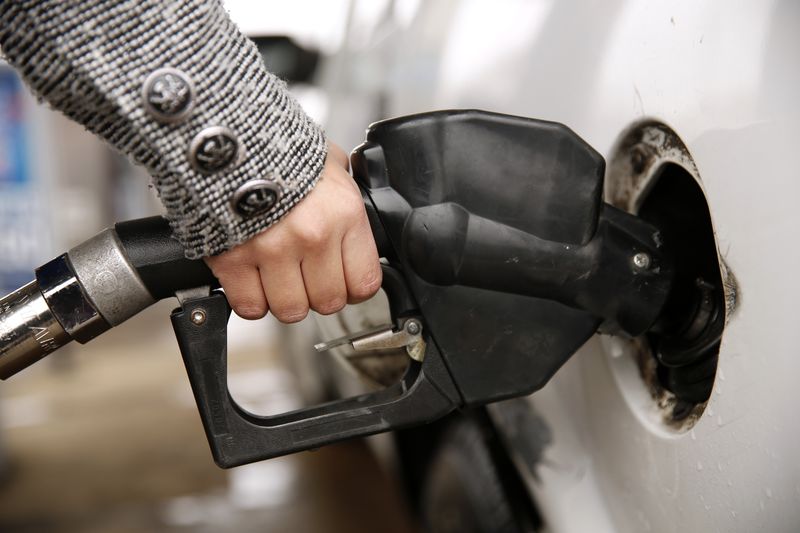By Jarrett Renshaw
NEW YORK (Reuters) - For the first time in more than a decade, U.S. gasoline prices are tumbling towards $2 (£1.27) a gallon even as the economy grows and unemployment shrinks, a constellation that will test the theory that domestic fuel demand is in terminal decline.
Conventional wisdom holds that long-term trends such as increased fuel efficiency, greater urbanization and a graying population will temper any potential pick-up in U.S. fuel consumption next year, despite the unexpected arrival of cheap fuel.
Yet there are some signs that the bounce could be bigger than is widely assumed. As U.S. gasoline use accounts for about one-tenth of global oil demand, an upside surprise could help put a floor under the biggest oil market selloff since 2008.
U.S. motorists are driving more highway miles than any time since 2006; sales of new SUVs and pick-up trucks are outpacing smaller, more fuel efficient models; and more travellers are choosing to drive this holiday season instead of flying.
"Historically, the current situation - falling gas prices and a growing economy - is unusual," said James Burkhard, Vice President and head of oil market research for IHS CERA. "The single most important factor in gasoline demand is economic growth and strong employment, and that's what we have right now."
The U.S. economy grew by 3.9 percent in the third quarter in a sign of improving economic - capping six months of the strongest expansion since 2003- and lower crude oil prices may add half a percentage point or more to growth in the new year.
Improving economic health is unlikely to restore the brisk growth in fuel demand that accompanied economic expansion for several decades.
"Historically, when the economy grows, the oil demand grows. But the correlation is not as strong now," said Christopher Knittel, a professor of energy economics at Massachusetts Institute of Technology Sloan School of Management.
The reason is a shift that took place in the last decade as consumers, angered by high gas prices, switched to more fuel efficient cars and gravitated to car pools and public transit, he said.
But consumers' response to the halving of U.S. gasoline pump prices since mid-2014 may produce an upward blip strong enough to surprise analysts who have grown increasingly bearish.
National fuel consumption has fallen 3.7 percent since 2010 and the U.S. Energy Information Administration forecast last week that it will dip further 0.3 percent next year to 8.86 million barrels per day. Some analysts now say that figure that may prove too pessimistic.
"There certainly could be a bounce, especially on the margins, where people are driving instead of flying and simply just driving more," said Wallace Tyner, an energy economist at Purdue University.
The average retail price for regular gasoline fell to $2.54 a gallon on Monday, its lowest since 2010 according to AAA, the nation's largest motorist organization. Gasoline could test $2.50 a gallon by Christmas, it said.
While motor fuel costs are tumbling, airfares have barely budged. Since Nov. 1, the price of an average U.S. round-trip airline ticket has remained around $540, according to data from Airlines Reporting Corporation.
LONGER DRIVES, BIGGER CARS
As a result, more travellers hit the road. AAA on Tuesday forecast that 4.2 percent more Americans would drive during the year-end holiday season, compared with a 1 percent increase in air travel. In September, U.S. drivers logged 246.6 billion miles, the highest tally for the month since 2006, according to the latest figures from the U.S. Department of Transportation.
Reflecting that, U.S. gasoline sales rose 0.3 percent in September to their highest level for the month since 2011, according to EIA data. It was the strongest growth rate in 10 months.
As often in the past, U.S. car buyers are also responding to cheaper fuel by shifting back in favour of larger, less fuel-efficient cars.
"The fact is the more that Americans believe that low prices are here to stay, true or not, the less they will care about fuel efficiency," says Patrick DeHaan, a senior petroleum analyst with GasBuddy.com.
The industry's annualised sales rate hit around 17.2 million vehicles in November, the highest since 2003, with SUVs and trucks topping the list with double digit increases, according to industry consultant Autodata Corp. Sales of Toyota Prius hybrid cars and subcompacts were both down, the figures show.
Reflecting that, fuel economy of vehicles sold last month remained flat for third straight month at 25.3 miles-per-gallon, falling from a record high 25.8 mpg in August, marking the longest period without efficiency gains since early 2012.
To be sure, U.S. motorists' love affair with big and powerful can only slow, or temporarily pause, a trend toward ever-more-efficient cars. Technological improvements and rules in force since 2012 that call for annual increases in fuel efficiency standards until 2025 are set to keep curbing fuel consumption.

"What we have today is that even when we have a good economy with low gas prices that are encouraging people to drive more, we are consuming less fuel," said Knittel.
(Reporting By Jarrett Renshaw; Editing by Jonathan Leff and Tomasz Janowski)